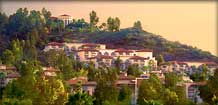|
|

This beautiful Resort course layout, on the Pointe Hilton Tapatio Cliffs Resort, weaves its way through rugged terrain that borders the Phoenix Mountain Preserve and offers spectacular views of both Lookout Mountain and Piestewa Peak.
The golf club has received the Golf Digest Four Star Award for nine consecutive years and has also been voted as one of the top 450 courses in the country by the same publication.
Lookout Mountain has received recognition as one of Americas Top Courses from 2005 through 2009 by participants in the Zagat Survey as well as being voted one of the Top Ten Public/Resort Courses in Arizona by the readers of Arizona Business Magazine for 2008 and 2009.
Featuring lush greens entwined by carefully preserved Sonoran Desert Terrain, this championship 18-hole course combines spectacular scenery with challenging play. In fact, you may see quail or even a coyote out on the course (please let them play through!)
The Verdict: Lookout Mountain Golf Club doesn't receive the publicity of many Scottsdale golf courses, but it's a solid choice.
As the round builds, the golf course turns more and more impressive. Once you get to the halfway house before the 10th tee, you know you're in for a memorable round of golf, having just played the seventh, eighth and ninth holes.
Lookout Mountain represents a nice change of pace from other golf courses in the area. And if you can, try to play it twice. The first time around, the greens can be a bear. Downhill putts often roll surprisingly far beyond the hole.

Package Notes:
Prices are per golfer based on 2 persons sharing a 2 room suite - includes all taxes. Prices are subject to change without notice. Accommodations and golf are subject to availability.
| Package Rates 2011-12: | |
| Nov 4 – Dec 25, 2011 | $370 |
| Dec 26 – 31, 2011 | $395 |
| Jan 1 – 19, 2012 | $435 |
| Jan 20 – Mar 8, 2012 | $455 |
| Mar 9 – 31, 2012 | $480 |
| Apr 1 – 7, 2012 | $465 |
| Apr 8 – 14, 2012 | $445 |
Course Opened:
1989
Course Type/Style:
Resort/Mountain
Number of Tee Boxes:
3 sets
Total Number of Sand Bunkers:
50-60
Number of Water Hazards:
3 of 18 holes
Most Challenging Hole:
No. 5
Most Memorable Hole:
No. 10
Sinature Hole:
No. 10
Acreage of Course:
acres
Average Size of Greens:
6,400 sq. ft.
Primary Grasses
Fairways:
Bermuda
Rough:
Bermuda
Greens:
Bermuda
Months Open:
January – December
High Season:
January – April
Aerification:
Overseeding: Sept. 27 – Oct 14
Rounds per year:
Green Fees:
Low: $49 High: $149
Walking Options:
Mandatory Cart
Director of Golf:
Jeff Raymond, PGA
Superintendent:
Paul Smith, GCSAA
Golf Digest ![]() rating
rating
By Chris King on May 4, 2010
The TPC-Myrtle Beach is one of the Grand Strand's bluebloods.
It enjoys the benefit of a premium brand, superior design (the team of Lanny Wadkins and Tom Fazio is tough to beat), and it's the home course of Dustin Johnson, a three-time winner on the PGA Tour. Throw in a bevy of national honors, and it's not hard to see why the facility is so highly regarded.
Identifying the three best holes on a course that has hosted what was then the Senior PGA Tour Championship and gets a regular workout from Johnson is a challenging task, because the candidates are plentiful. We asked course owner Chip Smith to identify the best of the best at TPC-Myrtle Beach and he complied, with an assist from Johnson.
The three best holes at TPC are:
No. 5, 158-yard, Par 3: Despite being TPC's shortest hole, the fifth is one of its most challenging, particularly from the tips where the tee shot requires a long forced carry over water. The green is wider than it is deep, so your margin for error is limited. A bunker in the right front looms for players not playing from the tips, as does a bunker in back of the green.
"There is almost a false front on the front of the green," Smith said. "It's a tough little shot because the green is narrow. The right side of the green is always better than short because of the lake."
No. 17, 193-yard, par 3: The words island green and TPC have almost become synonymous because of the famed 17th at Sawgrass, and No. 17 at TPC-Myrtle Beach is a reasonable approximation. The primary differences? The 17th in Myrtle Beach is a peninsula green surrounded by water on "only" three sides and it's approximately 50 yards longer. The 17th is TPC-Myrtle Beach's signature hole and with an almost constant wind, it represents a significant challenge. "Because of the distance, I think it's a little tougher than 17 at Sawgrass," Smith says. "Now I've never stood on 17 at Sawgrass on Sunday with $1.4 million on the line either (laugh)."
No. 18, 538-yard, par 5: The 18th, with a creek running along the right side of the fairway and a large lake on the left, is Johnson's choice as the course's best. It's a classic risk-reward hole. Players that can snuggle up to the creek before it runs out to the lake can get home in two, but there is considerable risk. Half of the green is exposed to water and with the rough surrounding it shaved, it's not an easy green to hold. One person who doesn't have to worry about length is Johnson. What does one of the PGA Tour's longest hitters use to reach the green on his second shot? "Depending on which way the wind is blowing, anywhere from a 5 or 6 iron to a 3-wood," he said. For the mere mortals among us, an iron on the second shot when attempting to reach the 18th green is out of the question!